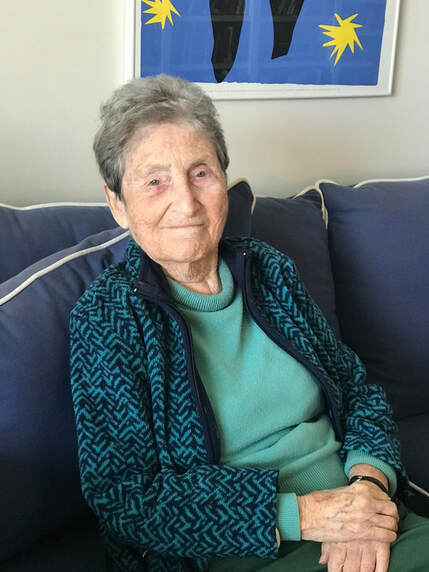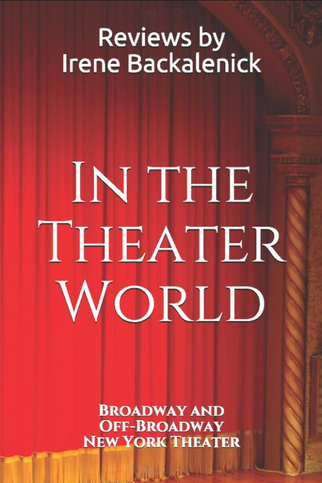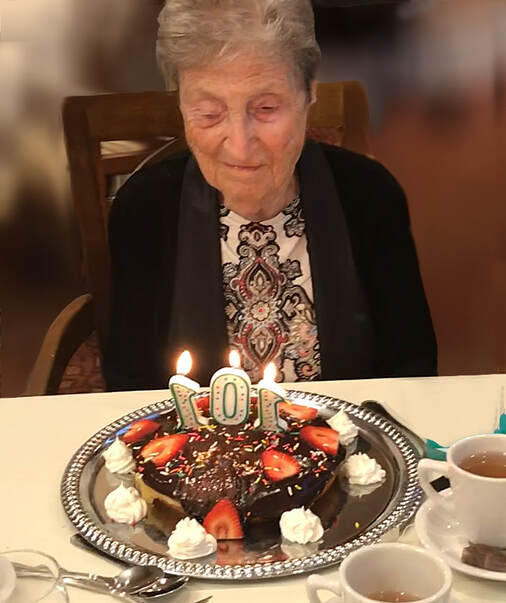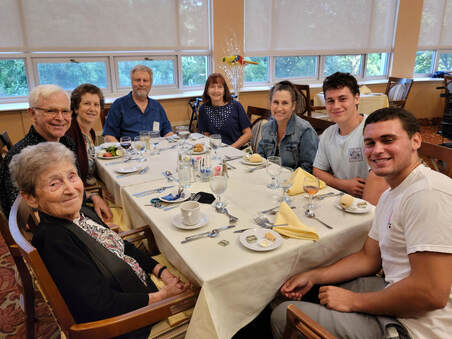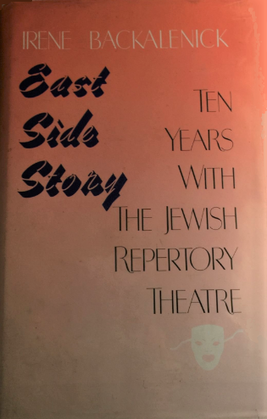November 2022 Featured Artist
101-Year-Young Poet Proves It’s Never Too Late to Reinvent Yourself
An Interview with Poet and Retired Freelance Journalist & Theater Critic
Irene Backalenick
Update December 16, 2023: Irene Louise Backalenick, née Margolis, 102, long-time resident of Westport, Connecticut, passed away peacefully in her apartment.
The Sanctuary Team celebrates the life and successes of this talented woman who shared her thoughts with our readers a little over a year ago. Her determination and willingness to reinvent herself and face challenges head-on is something we all can appreciate and learn from.
The Sanctuary Team celebrates the life and successes of this talented woman who shared her thoughts with our readers a little over a year ago. Her determination and willingness to reinvent herself and face challenges head-on is something we all can appreciate and learn from.
|
Irene Backalenick
(1921 - 2023) Photo Courtesy: Irene Backalenick |
At 101 years young, Irene Backalenick has had an admirable career as a longtime freelance journalist and theater critic, retiring in 2015 at the age of 94. Never one to stop learning, Irene took up a new passion in her 90s – writing poetry. Irene has written for numerous national publications, including The New York Times. In 1975, she received a New York Times Publisher's Award. Irene received several degrees: a B.A. from Brown University where she graduated summa cum laude (Phi Beta Kappa, Highest Honors in English Literature); an M.A. degree from the University of Bridgeport; and a Ph.D. in theatre history from City University of New York. Reared as an only child, with no community of her own, Irene formed her own communities. She is co-founder of the Connecticut Critics Circle and the Connecticut Press Club, and she is a member of the American Theatre Critics Association, among others. She is the author of two books of poetry and several plays, which began production at The Watermark in Bridgeport, Connecticut (a senior facility where she now lives). Productions were halted when the worldwide COVID-19 pandemic took effect. Irene married William Backalenick in 1947, a graphic artist who died in 2015. They had four children: Paul (married to artist Karen Loew), Lynn, Lisa, and Kim – all involved in the arts. |
Myrna Haskell, executive editor, was honored to speak with Irene at length about her career journey, the challenges she faced along the way, and her advice for healthy living.
You worked as a freelance journalist for The New York Times. Are there experiences you’d like to share during your stint there?
Well, I was glad that I had the impulse – when I didn’t have such impulses very often – to send a note to The New York Times with four or five story ideas. By then, I felt I had learned to write news articles. I had been writing for my hometown newspaper and the daily newspaper in the area, The Bridgeport Post.
When I approached The New York Times, it was around the beginning of the women’s lib movement, and one of my ideas was to write about that. So, they told me to go ahead, and I wrote about four or five women in the article. They found one of the women particularly interesting, so they asked me to write [another piece] specifically about her. Suzanne Benton was a sculptor up in Ridgefield [Connecticut], and that was my second article for The New York Times. From then on, I continued to send them several story ideas, and they would pick one, and I would write it.
One of my articles won a New York Times ‘Story of the Month Award’ about fathers raising their children alone. That was very nice.
You worked as a freelance journalist for The New York Times. Are there experiences you’d like to share during your stint there?
Well, I was glad that I had the impulse – when I didn’t have such impulses very often – to send a note to The New York Times with four or five story ideas. By then, I felt I had learned to write news articles. I had been writing for my hometown newspaper and the daily newspaper in the area, The Bridgeport Post.
When I approached The New York Times, it was around the beginning of the women’s lib movement, and one of my ideas was to write about that. So, they told me to go ahead, and I wrote about four or five women in the article. They found one of the women particularly interesting, so they asked me to write [another piece] specifically about her. Suzanne Benton was a sculptor up in Ridgefield [Connecticut], and that was my second article for The New York Times. From then on, I continued to send them several story ideas, and they would pick one, and I would write it.
One of my articles won a New York Times ‘Story of the Month Award’ about fathers raising their children alone. That was very nice.
What did you like and/or dislike about freelance work versus staff work?
I never made a real effort to apply for a [staff] position at a well-known magazine. In retrospect, I realize freelance was a good way to go because I wrote for many different publications choosing the articles and [subjects] I wanted to write about. At the time, I thought freelancers didn’t have the status that staffers had, but I realize now that the freelance work gave me a lot of freedom.
Were you on staff at a publication during the course of your career?
It was a little lonely writing for The New York Times [off on my own]. I didn’t get paid much for articles that took up to a month or more to write. So, I got a staff job at a weekly newspaper in Connecticut, the Trumble Times. People would ask, ‘How can you go from The New York Times to the Trumble Times?’ But I loved it – I really did.
After that, I went on to become a theater critic, and I pursued a doctorate in theater history. I reviewed for various publications. The very last piece I wrote was a piece of theater criticism.
I never made a real effort to apply for a [staff] position at a well-known magazine. In retrospect, I realize freelance was a good way to go because I wrote for many different publications choosing the articles and [subjects] I wanted to write about. At the time, I thought freelancers didn’t have the status that staffers had, but I realize now that the freelance work gave me a lot of freedom.
Were you on staff at a publication during the course of your career?
It was a little lonely writing for The New York Times [off on my own]. I didn’t get paid much for articles that took up to a month or more to write. So, I got a staff job at a weekly newspaper in Connecticut, the Trumble Times. People would ask, ‘How can you go from The New York Times to the Trumble Times?’ But I loved it – I really did.
After that, I went on to become a theater critic, and I pursued a doctorate in theater history. I reviewed for various publications. The very last piece I wrote was a piece of theater criticism.
|
Irene's Reviews of Productions from the 1990s through 2015
Click book cover to purchase. |
Thinking back on your years as a theater critic, are there any special memories you’d like to share?
The very last theater criticism I wrote was on Hamilton. I thought it was special. For the first time the [racial] bar was really crossed – the [complete and general acceptance] of a Black person playing a white role. People were going crazy for that musical, and the tickets went on a spending surge. I was in the fifth row center with two free press tickets. Irene starts to laugh. Finally, my career paid off financially. I had seen In the Heights, which was Miranda’s [Lin-Manuel Miranda] first musical about the Washington Heights neighborhood, and I loved that one, too. At this time, I was writing for Backstage and my local Bridgeport Post. What was your role with the Connecticut Critics Circle? I was an only child and a lonely child, too, I might add. My parents were first- and second-generation immigrants who just put food on the table and not much else in terms of providing any community at all. We were secular Jews and didn’t attend any congregations. |
|
I suppose I was always looking for community, so I sought them out. I got involved with theater critic groups. My best friend, David Rosenberg, who since died, and I co-founded the Connecticut Critics Circle. We were the first two members, and afterward started to invite others. We would always meet and talk theater over dinner. We followed each other’s reviews and would secretly comment on others’ reviews to each other. We began to meet regularly. I understand they are very active now. It’s still going very strong.
When I got here to this senior facility, I met another woman who had written for newspapers, and I suggested we start a writers’ workshop. She knew of a retired, creative writing professor who took a small group of us on. [This retired professor] was the one who pushed me into poetry. I had never written poetry before that. And she insisted only published writers could be part of the group. She was a snob! |
“The loss of my best friend/fellow theater critic/co-founder of the Connecticut Critics Circle is devastating, unacceptable. How shall we all go on without David?” ~ Irene Backalenick (Connecticut Critics Circle, July 2020) |
Forming groups or being part of groups was really important to me because I didn’t have that in my family at all.
|
Irene looks back upon a lifetime of successes and regrets,
of right turns and wrong turns. Click book covers to purchase. |
I’d love to hear more about your poetry.
I was in my early 90s when I started writing poetry. During that period of my life, it just poured out. But I’ve tried writing poetry recently, and I can’t do it. I think poetry controls itself – you’re not in control. When you sit down to write poetry, it happens to you. I never rhymed my poetry because I’m not comfortable with rhyming at all. But I look for unusual images, a tempo or rhythm…and I like a twist at the end that you don’t expect. One of your collections of poetry contained poems you wrote to your husband (Bill Backalenick, 1920-2015) after his death. That’s true. The title is Poems to Bill. These were eight poems that described his increasing illness and, ultimately, the end of his life. I put these together for his memorial. I remember that this woman came over to me at the ceremony and complimented me on the poems which I wasn’t expecting at all. |
|
I wish I was a better wife in a way. You know, my husband wasn’t interested in theater with the kind of passion I had for it. Instead, I discussed theater with my friend [David Rosenberg].
Was your husband interested in the arts at all? My husband was a graphic artist. He didn’t find words to express himself – he found paper and pen to express himself instead. Rueful Reflections (Books 1 & 2) were both published after the collection of poems about your husband. Is there a common theme? The poems in Poems to Bill are included in Rueful Reflections, Book 1. Most of the poems had an end or last line twist to them. I do think poetry writing afforded a kind of independence, certainly more so than journalism did. Do you have a favorite poet? I think it would be Emily Dickinson. Her style is so different from others. |
Irene paused during the interview to read one of her poems about Bill:
|
Our “Aging Gracefully” issue celebrates women who continue to reach goals, realize dreams, and reinvent themselves as they move through the decades. Did you have any challenges along the way – a challenge that may have held you back?
I was held back mostly in the early years. Slowly and sometimes impulsively, I started to make my own decisions along the way. Many of them were wrong decisions. I had no help in finding the answers to anything. My mother dressed me up like a doll but gave me no help in finding the answers to anything. As a woman back then, you could only imagine working as a secretary or working in a store. When I was in the fifth grade, I had to decide between an academic career and a business career. That’s a terrible thing to ask a ten-year-old kid. In the end, I decided to take a business course and become a secretary.
Much later, I was working as a school secretary surrounded by teachers. I saw that the teachers were making much more than I was. I started to think that maybe I could go to college, but I had no preparation. I had the nerve to go ask the school guidance counselor for advice. She didn’t tell me I was too old (I was several years older than most of the students at this point). Instead, she encouraged me and suggested I try for the best. She said, ‘Go to Brown University and ask them,’ and I took her advice. I was accepted, got tutored in French and algebra, and graduated summa cum laude.* I was older and more serious than most of the other students. I wasn’t sitting around and playing bridge.
I think what was typical of me – and I figured this out much later – was having a high IQ and low self-esteem, so I never tried a lot of things I should have.
*Irene graduated first in her class!
|
Photo Courtesy: Backalenick Family
|
What would you tell someone who thinks she’s too old to start something new.
I don’t think there’s any age when you’re too old to do something new. Any tips for our audience about healthy living – both physically and mentally? I never smoked at all, and I rarely drank [alcohol]. I took up a Japanese practice called Jin Shin Jyutsu [an ancient art of balancing the body's energy system, which facilitates healing and restores the body to a more harmonious state of being]. I studied with a practitioner. There are a number of exercises you can do, and I do some every night. I think it’s also very important for me to get down to dinner and talk with groups of people, engage with others. I’ve learned that the energy it takes to go down to the dining room really pays off. I always loved bike riding. My husband and I decided to get married on a long bike ride. I’ve always liked walking, too. Even now, I get out and walk every day. After my husband died, and for a while there, I had a very negative, depressed and fearful outlook because I suddenly realized I was turning 100, and it was frightening. But then I began to think about the fact that we don’t know the answer to whether or not there’s an afterlife or what there is to come. And I looked back at my whole life and reevaluated, and I began to have a more positive attitude about the past. And that positivity has really paid off for me. |
|
And my kids are just wonderful and very supportive.
How many children do you have? I had four. One of my kids passed away around the same time as my husband. [Irene’s oldest daughter, Lynn, passed away in December 2016.] Did you do anything special for your 101st birthday? We had a dinner party here. Being with my family is special and makes me happy. Where do you find sanctuary? Recently, a group of teaching nuns moved in here. I was writing little biographies about new residents for the newsletter. As I got to know the nuns, it was easy to embrace their upbeat attitude after a while…not that I’m about to become a nun! We both laugh. But they’ve given me a more upbeat outlook on life. |
Irene's 101st Birthday Celebration
L to R (Clockwise): Irene, Jim Kendrick (son-in-law), Lisa Backalenick (daughter), Paul Backalenick (son), Karen Loew (daughter-in-law, wife to Paul), Kim Escobar (daughter), Kai Escobar (grandson), Ethan Escobar (grandson) Photo Couresy: Backalenick Family |
|
More of Irene's poems can be found in:
POETRY CORNER East Side Story, based on her doctoral thesis,
won a national book award in history. |

